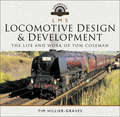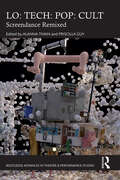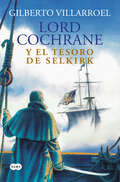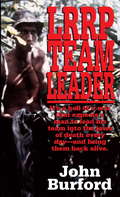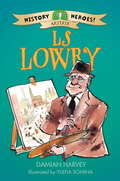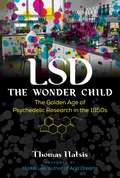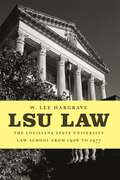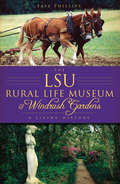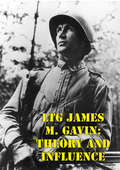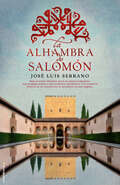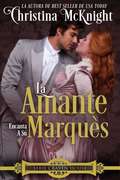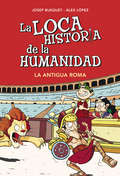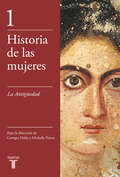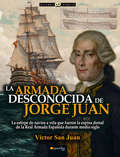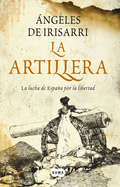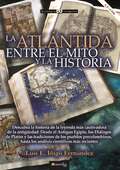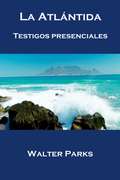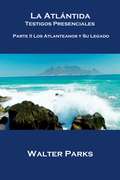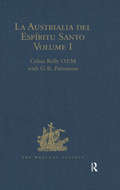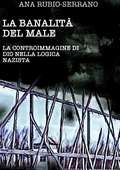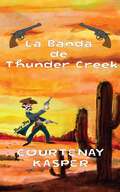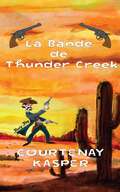- Table View
- List View
LMS Locomotive Design & Development: The Life and Work of Tom Coleman (Locomotive Portfolio Ser.)
by Tim Hillier-GravesIn 1958 one of Britain`s greatest locomotive designers died without public fanfare or recognition, mourned only by his family. Yet William Stanier, arguably one of our greatest engineers and his leader, said of him that without his Chief Draughtsman all he achieved with the LMS would not have been possible. How could such a man slip from our view and remain anonymous, although his Princess Coronations, Black 5s and 8Fs are regarded as three of the finest classes of locomotive ever built? And today many survive as stars to grace the ever growing preservation movement.In reality, Tom Coleman was an intensely private and modest man who never sought recognition or commendation. His need for privacy may be one reason why his life has remained shrouded in mystery for so long, but finally his story has been slowly pieced together from a wide variety of sources, many previously untapped. So now we can see for ourselves his great contribution to railway history and recognise his singular talents.
LO: Screendance Remixed (ISSN)
by Alanna Thain Priscilla GuyThis edited collection assembles international perspectives from artists, academics, and curators in the field to bring the insights of screendance theory and practice back into conversations with critical methods, at the intersections of popular culture, low-tech media practices, dance, and movement studies, and the minoritarian perspectives of feminism, queer theory, critical race studies and more.This book represents new vectors in screendance studies, featuring contributions by both artists and theoreticians, some of the most established voices in the field as well as the next generation of emerging scholars, artists, and curators. It builds on the foundational cartographies of screendance studies that attempted to sketch out what was particular to this practice. Sampling and reworking established forms of inquiry, artistic practice and spectatorial habits, and suspending and reorienting gestures into minoritarian forms, these conversations consider the affordances of screendance for reimaging the relations of bodies, technologies, and media today.This collection will be of great interest to students and scholars in dance studies, performance studies, cinema and media studies, feminist studies, and cultural studies.
LORD COCHRANE Y EL TESORO DEL SELKIRK (E
by GILBERTO VILLARROELEl marino más audaz de todos los tiempos regresa en una aventura de piratas. Chile, 1822. Terremoto y maremoto en Valparaíso. Lord Cochrane, almirante de la escuadra chilena, le salva la vida al general Bernardo O'Higgins. A manera de agradecimiento, el Director Supremo revela que una vez estuvo a punto de despedirlo y de ofrecerle, como compensación, el archipiélago de Juan Fernández. Y que, en Robinson Crusoe, la isla principal del archipiélago, el corsario Alexander Selkirk escondió en 1704 un tesoro que nadie ha podido encontrar. Todo indica que el tesoro es una reliquia que Selkirk trajo consigo desde una región del estrecho de Magallanes que los aborígenes llaman Las Montañas de la Locura. Este lugar habría sido el primer hogar en la Tierra de un dios venido desde las estrellas, el inmortal Cthulhu. Intrigado, Lord Cochrane parte hacia Juan Fernández junto a su amiga Maria Graham y al capitán Eonet. Lo mismo hace un antiguo enemigo suyo, el capitán Gervasio Corrochano, un ex oficial de la Armada española que ahora está al mando de un buque pirata, el Águila.
LRRP Team Leader: A Memoir of Vietnam
by John BurfordVietnam, 1968. All of Sergeant John Burford's missions with F Company, 58th Infantry were deep in hostile territory. As leader of a six-man LRRP team, he found the enemy, staged ambushes, called in precision strikes, and rescued downed pilots. The lives of the entire team depended on his leadership and their combined skill and guts. A single mistake--a moment of panic--could mean death for everyone.From the Paperback edition.
LS Lowry
by Damian HarveyFollow the life of LS Lowry from his childhood industrial roots to becoming a modern day celebrity artist.Discover the stories of people who have helped to shape history, ranging from early explorers such as Christopher Columbus to more modern figures like Tim Berners-Lee, inventor of the World Wide Web.These chapter books combine historical fact with engaging narrative and humourous illustration, perfect for the newly independent reader.
LS Lowry (History Heroes #8)
by Damian HarveyFollow the life of LS Lowry from his childhood industrial roots to becoming a modern day celebrity artist.Discover the stories of people who have helped to shape history, ranging from early explorers such as Christopher Columbus to more modern figures like Tim Berners-Lee, inventor of the World Wide Web.These chapter books combine historical fact with engaging narrative and humourous illustration, perfect for the newly independent reader.
LSD — The Wonder Child: The Golden Age of Psychedelic Research in the 1950s
by Thomas Hatsis• Explores the different groups--from research labs to the military--who were seeking how best to utilize LSD and other promising psychedelics like mescaline • Reintroduces forgotten scientists like Robert Hyde and Rosalind Heywood • Looks at the CIA&’s notorious top-secret mind-control program MKUltra • Reveals how intellectuals, philosophers, artists, and mystics of the 1950s used LSD to bring ancient rites into the modern ageExploring the initial stages of psychedelic study in Europe and America, Thomas Hatsis offers a full history of the psychedelic-fueled revolution in healing and consciousness expansion that blossomed in the 1950s--the first &“golden age&” of psychedelic research. Revealing LSD as a &“wonder child&” rather than Albert Hofmann&’s infamous &“problem child,&” the author focuses on the extensive studies with LSD that took place in the &’50s. He explores the different groups--from research labs to the military to bohemian art circles--who were seeking how best to utilize LSD and other promising psychedelics like mescaline. Sharing the details of many primary source medical reports, the author examines how doctors saw LSD as a tool to gain access to the minds of schizophrenics and thus better understand the causes of mental illness.The author also looks at how the CIA believed LSD could be turned into a powerful mind-control weapon, including a full account of the notorious top-secret program MKUltra. Reintroducing forgotten scientists like Robert Hyde, the first American to take LSD, and parapsychologist Rosalind Heywood, who believed LSD and mescaline opened doors to mystical and psychic abilities, the author also discusses how the infl uences of Central American mushroom ceremonies and peyote rites crossbred with experimental Western mysticism during the 1950s, turning LSD from a possible madness mimicker or mind weapon into a sacramental medicine. Finally, he explores how philosophers, parapsychologists, and mystics sought to use LSD to usher in a new age of human awareness.
LSU Law: The Louisiana State University Law School from 1906 to 1977
by W. Lee HargraveFrom its founding in 1906, the Louisiana State University Law School has offered its students a truly distinctive legal education. Integrated programs in Louisiana’s unique civil law, in Anglo-American common law and federal law, and in international and comparative law create a global law curriculum recognized for both its academic excellence and its outstanding teaching, research, and public service faculty. In LSU Law, alumnus and professor W. Lee Hargrave chronicles the first seventy years of this institution—from its opening classes to the death of its longtime dean, Paul M. Hebert, and its transformation into an autonomous Law Center. He reveals the faces and forces that have helped to create the special mystique surrounding the school and the significance attached to a law degree from LSU.After an initial discussion of the legal profession in Louisiana before the establishment of formal academic instruction, Hargrave maps the school’s growth and development. He charts the organizational difficulties of the early years, reputation building in the twenties, politically influenced extravagance in the thirties, wartime challenges in the forties, return to normalcy in the fifties, steady growth in the sixties, and overcrowding in the seventies. Throughout, he explores all aspects of the school—its administrators and faculty, student body, shifting admission requirements, curriculum, grading system debates, influence on Louisiana’s legal community and state government, and much more. He also describes how students lived and learned during each era and discusses the effects of outside people and events—including Huey P. Long, World War II, and the civil rights movement—on the school. Hargrave tells the history of the LSU Law School in the context of changes that occurred in legal education throughout the United States, making his work of interest to legal historians and the national law school community. Alumni will also appreciate this detailed study of what has become a Louisiana institution.
LSU Rural Life Museum and Windrush Gardens, The: A Living History
by Faye PhillipsIn 1861, Louisiana settler William S. Pike established an incredible five-hundred-acre plantation seven miles from the heart of present-day Baton Rouge. His progeny continued to cherish the land for generations, all while pursuing unique and active lives. William Stephen Pike Burden Jr. became an amateur magician, and Ollie Brice Steele Burden, inspired by the formal gardens of Europe, designed Windrush Gardens. Today, the land is home to Louisiana State University's Rural Life Museum and houses rare collections of Louisiana folk life and working plantation materials. In this comprehensive history of LSU's beloved landmark, archivist Faye Phillips brings to life the hardships and toils, vision and determination of families in eighteenth- and nineteenth-century Louisiana.
LTG James M. Gavin: Theory And Influence
by Major Edward P. GavinThis monograph approached Lieutenant General James M. Gavin as a military theorist and explored his influence as the Army transitioned from World War II to the Cold War. Gavin's theory of future warfare required an army with capability in atomic and non-atomic warfare and he recognized the need for readiness for both limited peripheral wars and general war. His theory shaped his vision of the functions, organizations, and technology required to succeed in future conflicts. Gavin organized much of his writing around the concepts of mobility, firepower, and control that he felt were critical for future warfare. His influence shaped development of tactical nuclear weapons, missiles, air mobility, and organizational transformation following World War II and into the Cold War.Gavin's theory of future warfare, his understanding of the Soviet threat, and his concepts of firepower, mobility, and control informed his model of how the Army should organize for future warfare. He envisioned flexible division organizations, capable of fighting dispersed over significant depth, enabled by superior air and ground mobility to deliver firepower adequate prevail on future battlefields...The organization that epitomized Gavin's concepts was the air mobile division that developed from his sky cavalry concept. Gavin's advocacy for the air mobility concept and his specific actions to advance personnel and positions to build and refine sky cavalry and air mobility capabilities were key factors in the eventual development and acceptance of the airmobile division. While airmobile divisions and sky cavalry would likely have emerged without Gavin, his influence clearly advanced the ideas and shaped the form of the organizations.
La Alhambra de Salomón
by José Luis SerranoBajo la actual Alhambra laten un palacio legendario, una sinagoga mística y una residencia paradisíaca. Y la verdadera historia de su construcción se encuentra en estas páginas. Corre el año 1002. Tras la muerte del padre, la familia Nagrela llega a Córdoba, capital de Al Ándalus y la ciudad más grande del mundo. La historia de una época de esplendor y cultura. Una historia de amor y de luchas familiares. La historia de la construcción de la Alhambra de Granada.Allí establecen su negocio de plantas medicinales y remedios de espagírica. Samuel Nagrela, el segundo varón de la familia, cultiva el comercio y, al mismo tiempo, estudia la ciencia de los griegos, la jurisprudencia judía, el derecho musulmán, el Corán, la Biblia, el Tamud, la lengua aramea, la medicina hipocrática y un oficio que habría de cambiarle la vida: el de calígrafo de la lengua árabe.En el 1013 el ya rabino Samuel inicia su viaje de exilio, tras la guerra civil. Está convencido de que lo guía la Divina Providencia y de que algún día será príncipe de todos los judíos andalusíes. En ese viaje iniciático conocerá a Ilbia, una joven noble recluida en el castillo de Salobreña, con asombrosos conocimientos matemáticos y arquitectónicos, y que habría de convertirse en la mujer de su vida y en la artífice de su sueño: años más tarde, convertido ya en un hombre rico y poderoso, Samuel construirá el nuevo templo de Salomón.
La Amante Encanta a Su Marquès
by Christina McKnightEl nieto de un marqués poco convencional e hijo de una mujer desgraciadamente famosa, Elijah Watson, Marqués de Ridgefeld, ha pasado la mayor parte de su vida fuera de Londres. Su crianza atípica le ha dejado un profundo deseo de echar raíces y de llevar la vida de una familia tradicional, y está determinado a vivir más allá de todo reproche. Cuando conoce a la señorita Samantha Pengarden, cree que ha encontrado la mujer con la cual desea casarse –excepto que ella le tiene reservadas otras ideas mucho más sensuales. Conocida en la alta sociedad como la hija rebelde e ilegítima de la no muy respetable madama de la londinense Craven House, Samantha nunca antes había tenido que enfrentar al mundo sin su tímida gemela –hasta ahora. El casamiento de su hermana y el regreso del canalla de su padre la dejan sola y sin rumbo. Cuando Elijah accede a acompañarla a los sitios de la peor calaña de la ciudad, piensa que por fin ha encontrado un hombre con un gusto por el escándalo y el conocimiento de los asuntos de la carne. Pero nunca contó con que Elijah fuera tan honorable. Cuando el nombre de Samantha aparece como la amante del Marqués de Ridgefeld en una lista en el libro de apuesta del club de caballeros White, su reputación está en ruinas –y solo Elijah puede salvarla. ¿Podrán dos almas completamente opuestas unirse en un amor que es seguro durará por siempre?
La Antigua Roma (La loca historia de la humanidad #Volumen 2)
by Josep Busquet Àlex López¿Sabías que...En el Circo Máximo cabían más espectadores que en un estadio de fútbol?La mascota favorita de Julio César era una jirafa?En la Antigua Roma llegó a estar prohibido llevar pantalones?¡Descubre el mundo antiguo con LOS TEMPO, la familia más alocada y aventurera de todos los tiempos!INCLUYE:PasatiemposCómicsBastantes romanosAlgunos leonesMucho, mucho humor
La Antigüedad: La Antigüedad (Historia de las mujeres #Volumen 1)
by Georges DubyEsta obra busca analizar cómo las relaciones de los sexos condicionan la evolución de las sociedades y la necesidad de que las mujeres encuentren, al fin, su espacio propio. Esta Historia de las mujeres responde a la necesidad de ceder la palabra a las mujeres. Alejadas, desde la Antigüedad, del escenario donde se enfrentan a los dueños del destino, reconstruir su historia significa describir su lento acceso a los medios de expresión y su conversión en persona que asume un papel protagonista. Este análisis implica, asimismo, que las relaciones entre los sexos condicionan los acontecimientos, o la evolución de las sociedades. No se buscan conclusiones tajantes sino que las mujeres encuentren, al fin, su espacio propio. Tomando la periodización habitual y el espacio del mundo occidental, esta obra se divide en cinco volúmenes independientes pero complementarios. Este primer volumen trata de las funciones y roles sociales de las mujeres en la Grecia antigua y en Roma.
La Argentina
by María Sáenz QuesadaLa Argentina. Historia del país y de su gente, de María Sáenz Quesada, sintetiza el recorrido histórico que va desde la fundación de la sociedad colonial hasta nuestros días. Este singular relato historiográfico abarca la construcción de la República del siglo XIX, la gran inmigración y la prosperidad económica, la inestabilidad política en el siglo XX y la crisis de comienzos del milenio, la debacle del 2001 y el período de recuperación iniciado con las presidencias de Néstor Kirchner y Cristina Fernández. El texto, rigurosamente cronológico, consta de 74 capítulos pensados para ser leídos en forma independiente. Se organiza alrededor de los hechos políticos sobresalientes, pero incluye referencias a la vida privada, rasgos biográficos de los protagonistas, el clima de ideas y la sensibilidad de cada época, además de ejemplos para que el pasado se humanice y se vuelva más cercano y comprensible. Serio y entretenido a la vez, este libro se constituye en una obra indispensable para el conocimiento y el estudio de nuestra historia, y resulta un excelente auxiliar en la indagación de la identidad, un tema clave de nuestra cultura en el comienzo del tercer milenio.
La Argentina (Edición Corregida y Actualizada): Historia del país y de su gente
by María Sáenz QuesadaSáenz Quesada sintetiza el recorrido histórico y cronológico que vadesde la fundación de la sociedad colonial hasta la actualidad. Son 74capítulos pensados para ser leídos en forma independiente, que incluyenlos hechos políticos sobresalientes, pero también referencias a la vidaprivada, rasgos biográficos de los protagonistas, el clima de ideas y lasensibilidad de cada época, además de ejemplos para que el pasado sehumanice y se vuelva más cercano y comprensible. Este singular relato historiográfico abarca la construcción de laRepública del siglo XIX, la gran inmigración y la prosperidad económica,la inestabilidad política en el siglo XX y la crisis de comienzos delmilenio, la debacle del 2001y el período de recuperación iniciado conlas presidencias de Néstor Kirchner y Cristina Fernández.Serio y entretenido a la vez, este libro se constituye en una obraindispensable para el conocimiento y el estudio de la historiaargentina, y resulta un excelente auxiliar en la indagación de laidentidad.
La Armada desconocida de Jorge Juan (Historia Incógnita)
by Víctor San JuanDon Jorge Juan y Santacilia: Marino, ingeniero, explorador, científico, literato. Genio de la construcción naval. Descubra la gran aventura del diseño y construcción de estos avanzados navíos a vela y su participación en los episodios clave de la historia española de los Siglos XVIII y XIX. Una generación de buques injustamente olvidada que marcaron toda una época.Conozca la obra del ilustrado, científico, capitán de navío Jorge Juan, a través de su legado, medio centenar de navíos construidos entre 1751 y 1769, algunos de los cuales, como el Santísima Trinidad, Septentrión, Guerrero, Vencedor, Glorioso, Velasco, Princesa o Santiago de España, marcaron toda una época. Esta es su historia y, a través de ellos, del genio que los construyó. Estamos acostumbrados a considerar la figura del matemático, marino e ilustrado español Jorge Juan bajo el prisma histórico de su obra científica, sus aventuras en Iberoamérica, Inglaterra y Marruecos o su valor como representante de la ilustración española; pero nunca se ha hecho un inventario de la que fue su gran obra, los navíos que se construyeron bajo su dirección.
La Artillera
by Ángeles De IrisarriLa lucha de España por la igualdad. Agustina de Aragón, conocida como la Artillera, junto a la condesa de Bureta, Manuela Sancho, Casta Álvarez, María Lostal, María Agustín y la madre Rafols sobrevivieron en una ciudad en la que el cronista Casamayor escribió que los atacantes -más parecían Nerones que franceses-, en la que el último muerto dejaba enseguida de ser último en una sucesión aterradora. Estas mujeres y otras, y otros muchos hombres, sin nada que llevarse a la boca y rodeados de muertos, pues la peste hizo acto de presencia en Zaragoza en lo más crudo del invierno y del combate, quedaron inscritas con letras de oro en la Historia de España por sus heroicos hechos en defensa de la libertad. Ángeles de Irisarri recrea en esta novela el día a día de la guerra muros adentro de la ciudad a través de diez mujeres, unas reales, otras imaginarias, que representan a todas las clases sociales y que, al grito de «Vencer o morir», fueron capaces de tomar las armas y hasta disparar cañones.
La Atlántida (Historia Incógnita)
by Luis E. Íñigo FernándezEntre el mito y la historia. Descubra la historia de la leyenda más cautivadora de la antigüedad: Desde el Antiguo Egipto, los Diálogos de Platón y las ancestrales tradiciones de los pueblos precolombinos, hasta los más profundos análisis científicos recientes. La apasionante investigación histórica de los orígenes del mito de la Atlántida, desde los Diálogos platónicos, la tradición egipcia, griega y romana, las tradiciones ancestrales de los pueblos precolombinos, la evolución del mito en la Edad Media y Moderna y su influencia en los navegantes como Cristóbal Colon, hasta su relación con el género utópico en el renacimiento y su diversificación en el siglo XIX: Julio Verne, Donnelly, madame Blavatsky, Edgar Cayce, el enfoque étnico supremacista de la Alemania nazi y los mitos de las otras Atlántidas, como Mu o Lemuria. La Atlántida es, quizá, el mito por excelencia de la cultura occidental en los últimos siglos. Para muchos, no existió nunca más allá de la imaginación de Platón, que quiso valerse de ella para enseñar una lección de política a sus seguidores; para otros su existencia fue tan real como la de cualquier otra de las grandes civilizaciones de la Antigüedad.
La Atlántida Testigos Presenciales
by Silvana Borghi Walter ParksANTIGUOS DOCUMENTOS, RESTOS Y UTENSILIOS PROVENIENTES DE LA ATLÁNTIDA PRUEBAN SU EXISTENCIA. ¿MITO O REALIDAD? Muchos creían que la Atlántida fue una novela de ficción creada por Platón. Puesél no fue el primero en escribir sobre ella. Hemos encontrado un documento anterior a los escritos de Platón, proveniente del año 9619 A:C:, más de 9000 años antes del escrito por Platón. Además, hemos reunido suficiente evidencia en cuanto a los hallazgos arqueológicos y a los hechos científicos para proporcionar pruebas convincentes de que la Atlántida existió realmente. Y hemos encontrado los restos. Estructuramos la evidencia de respuestas 3 preguntas básicas: ¿Cómo se creó la Atlántida; tuvo que dejar evidencia, o una herencia; ¿cómo fue destruida? Lo invito a adentrarse a este mundo de las antiguas sociedades y los escritos antiguos. Vayamos y descubramos la Atlántida.
La Atlántida Testigos Presenciales Parte II Los Atlanteanos y Su Legado
by Walter Parks Cinthia Noemi MascarellMuchos han creído que la Atlántida es una historia de ficción creada por Platón. Bien, pues Platón no fue el primero en escribir sobre ella. Hemos encontrado un documento mucho más antiguo. Fue escrito en el año 9619 AC, alrededor de 9250 años antes de los escritos de Platón. Además, hemos reunido evidencias científicas y arqueológicas suficientes para constatar que la Atlántida fue real. Y hemos hallado sus restos. Organizamos la evidencia como respuestas a 3 preguntas básicas: ¿cómo fue creada la Atlántida?, ¿dejó evidencia de su existencia o un legado?, ¿Cómo fue destruida? Este libro electrónico es la parte II.
La Austrialia del Espíritu Santo: The Journal of Fray Martin de Munilla O.F.M. and other documents relating to The Voyage of Pedro Fernández de Quirós to the South Sea (1605-1606) and the Franciscan missionary plan (1617-1627)
by Celsus Kelly O.F.M G. R. ParsonsonPedro Fernández de Quirós was a remarkable navigator and explorer. Having sailed in 1595 as chief pilot in the ill-fated Spanish expedition to the Solomon Islands, he returned to the 'Austral Lands' - the area of the New Hebrides - in 1605 with another expedition, which is the subject of this volume. In his Introduction Father Kelly sets out to resolve some of the outstanding historical problems of this Quirós expedition in the light of recently discovered documents. At the same time he gives a brief description of the Franciscan missionary apostolate, its contribution to geographical discovery in the Pacific, and its missionary plans for the natives of the Austral lands. He also provides a systematic survey of source material in Spanish, Roman and other European archives. The volume contains 32 documents concerning the 1605 expedition, including Munilla's Relación, as well as the Franciscan Missionary Plan. All these have been translated by Father Kelly. Continued in Second Series 127, with which the main pagination is continuous. This is a new print-on-demand hardback edition of the volume first published in 1966.
La Banalità del Male: La Controimmagine di Dio nella Logica Nazista
by Ana Rubio-SerranoL'obiettivo di questo libro non è mostrare soltanto l'Auschwitz storico, ma piuttosto l'Auschwitz che si è radicato nell'essere umano: la non capacità di distinguere il bene dal male; l'offuscamento per riaffermare la propria identità come la sola umana e l'impossibilità di pensare l'alterità, in modo tale che tutto questo ancora oggi persiste come eredità, della quale il nostro mondo è tanto esecutore testamentario quanto erede. Auschwitz è quindi il punto di partenza ma non il punto di arrivo. È uno studio in cui si mostra il modello di anti-uomo che nasce dall'antropologia nazista contraria al modello di uomo che rivela l'antropologia cristiana. Pubblicazione parziale della sua tesi di dottorato.
La Banda De Thunder Creek
by Courtenay KasperCuenta la historia de Ridge, un niño y su familia, y cómo encontró a Dios a través de su vida como abuelo
La Bande de Thunder Creek
by Courtenay KasperRidge Jones, onze ans, et sa sœur jumelle Libby découvrent que leur grand-père n’est pas le shérif qu’ils croyaient, ce qui les entraîne dans une aventure de la ruée vers l’or, de Cache Creek à Barkerville. Les jumeaux, terrifiés par les hors-la-loi tels que Rusty Roy, Bad Barry et leur bande ridicule de braqueur de trains, doivent se ruer à Barkerville avant qu’il ne soit trop tard pour sauver leur famille. Un aventure en pleine conquête de l’Ouest, avec de l’espoir, de la foi, et une chèvre insolente. Une histoire qui vous redonnera le sourire et l’espoir dans les moments difficiles !
